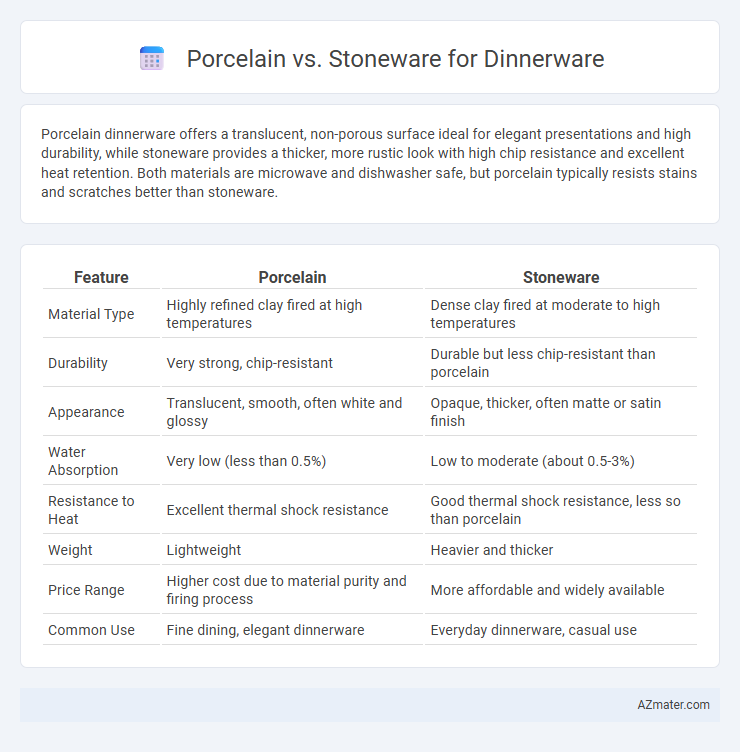Porcelain dinnerware offers a translucent, non-porous surface ideal for elegant presentations and high durability, while stoneware provides a thicker, more rustic look with high chip resistance and excellent heat retention. Both materials are microwave and dishwasher safe, but porcelain typically resists stains and scratches better than stoneware.
Table of Comparison
| Feature | Porcelain | Stoneware |
|---|---|---|
| Material Type | Highly refined clay fired at high temperatures | Dense clay fired at moderate to high temperatures |
| Durability | Very strong, chip-resistant | Durable but less chip-resistant than porcelain |
| Appearance | Translucent, smooth, often white and glossy | Opaque, thicker, often matte or satin finish |
| Water Absorption | Very low (less than 0.5%) | Low to moderate (about 0.5-3%) |
| Resistance to Heat | Excellent thermal shock resistance | Good thermal shock resistance, less so than porcelain |
| Weight | Lightweight | Heavier and thicker |
| Price Range | Higher cost due to material purity and firing process | More affordable and widely available |
| Common Use | Fine dining, elegant dinnerware | Everyday dinnerware, casual use |
Introduction to Porcelain and Stoneware
Porcelain dinnerware is crafted from refined kaolin clay, fired at extremely high temperatures between 1,200degC and 1,400degC, resulting in a translucent, non-porous, and highly durable surface that resists chipping and scratching. Stoneware, made from denser clay fired at slightly lower temperatures ranging from 1,100degC to 1,200degC, offers a robust and opaque finish with a heavier weight and rustic appearance, emphasizing durability and casual use. Both materials provide distinct advantages in terms of strength, aesthetics, and usability, catering to different dining experiences and preferences.
What is Porcelain Dinnerware?
Porcelain dinnerware is crafted from a refined combination of kaolin clay, feldspar, and quartz, fired at extremely high temperatures around 2300degF (1260degC) to achieve a dense, vitrified body known for its strength and translucence. This type of dinnerware is prized for its smooth, non-porous surface that resists chipping and staining, making it highly durable and ideal for everyday use as well as formal dining settings. Porcelain's elegant white appearance and ability to withstand thermal shock without cracking differentiate it from other materials like stoneware, which tends to be heavier and more opaque.
What is Stoneware Dinnerware?
Stoneware dinnerware is a type of pottery made from dense clay fired at high temperatures between 1,200degC and 1,315degC, resulting in a durable, chip-resistant material with a slightly coarse texture. Unlike porcelain, stoneware is opaque and has a heavier, more rustic feel, often exhibiting earthy tones or speckled finishes due to its iron-rich clay composition. Its non-porous surface makes it resistant to moisture and stains, making stoneware dinnerware ideal for everyday use with practical durability and versatile aesthetic appeal.
Durability: Porcelain vs Stoneware
Porcelain offers superior durability due to its high density and vitrification, making it resistant to chipping, cracking, and thermal shock. Stoneware, though sturdy and heavier, is more porous and prone to crazing or chipping over time with frequent use. For long-lasting dinnerware, porcelain consistently outperforms stoneware in strength and resistance to wear.
Appearance and Design Differences
Porcelain dinnerware boasts a translucent, smooth surface with a glossy finish that enhances intricate designs and vibrant colors, making it ideal for elegant table settings. Stoneware features a more rustic, opaque appearance with a matte or satin finish, often showcasing earthy tones and textures that emphasize handcrafted artistry. The design palette for porcelain leans toward fine, detailed patterns, while stoneware embraces organic shapes and natural imperfections that contribute to its unique aesthetic.
Weight and Feel Comparison
Porcelain dinnerware is typically lighter and more delicate in feel compared to stoneware, which is denser and heavier, providing a sturdy, substantial grip. Porcelain's fine, smooth texture allows for a refined dining experience, whereas stoneware's thicker composition contributes to durability and a rustic, tactile quality. Weight differences influence comfort during use and storage, with porcelain favored for elegance and stoneware prized for resilience.
Heat Resistance and Microwave Safety
Porcelain dinnerware offers superior heat resistance due to its dense, vitrified structure, making it safe for microwave use without risk of cracking or leaching. Stoneware, while durable and capable of withstanding high temperatures, may be more prone to thermal shock and uneven heating in microwaves. Choosing porcelain ensures consistent microwave safety and longevity under frequent heating conditions.
Maintenance and Cleaning Requirements
Porcelain dinnerware features a non-porous surface that resists stains and odors, making it easier to clean with mild detergents and dishwasher-safe advantages. Stoneware, being more porous, requires careful cleaning to prevent absorption of oils and food particles, often needing hand washing and thorough drying to avoid damage or odor retention. Both materials benefit from avoiding abrasive cleaners, but porcelain's smoother glaze generally demands less maintenance and retains its appearance longer under regular use.
Price Range and Value for Money
Porcelain dinnerware typically ranges from $20 to $150 per piece, offering a high-end, elegant look with excellent durability and chip resistance, making it a valuable long-term investment. Stoneware is generally more affordable, priced between $10 and $70 per piece, providing robustness and a rustic aesthetic but may be heavier and prone to chipping over time. When considering value for money, porcelain is ideal for formal settings and longevity, while stoneware suits casual dining with budget-friendly options.
Choosing the Best Dinnerware for Your Needs
Porcelain dinnerware offers a lightweight design with a smooth, non-porous surface resistant to stains and chipping, making it ideal for formal dining and frequent use. Stoneware provides a more durable, rustic aesthetic with thicker, heavier construction and excellent heat retention, perfect for casual meals and everyday use. Consider factors like durability, style preference, maintenance, and intended use when choosing between porcelain and stoneware to find the best dinnerware for your needs.

Infographic: Porcelain vs Stoneware for Dinnerware
 azmater.com
azmater.com